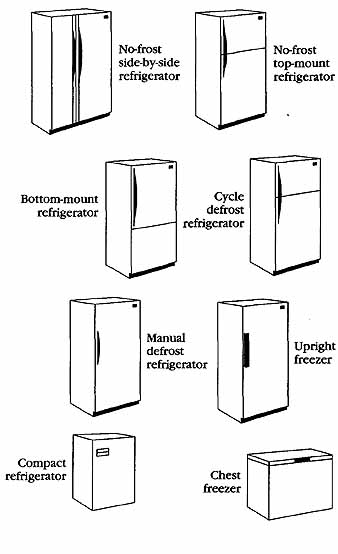Selecting, purchasing, and installing: Refrigerators and freezers
| HOME | Troubleshooting | DIY Tips |
|
As with other kitchen appliances, refrigerators and freezers come in a wide variety of styles, sizes, and colors ( Fig. __10). Some designs might meet the needs of a family member who has a physical or mental limitation better than others. Some questions to consider when choosing a refrigerator are: • Does it have a true no-frost system, to do away with manual defrosting? • Does it have an automatic ice maker, which produces ice without trays to fill or empty? • Does it have in-the-door dispensers to deliver ice and cold water, without opening the door? • Does it have shelves, bins, and drawers which pull out to make reachable those foods stored at the back? There are five basic types of refrigerators that are on the market today. • Compacts or portables: 1’/ to 6 cubic feet (12” to 24” wide) • Single-door models: 9 to 14 cubic feet (23” to 30” wide) • Top-mount refrigerator-freezer combination: 10 to 23 cubic feet (24” to 33” wide) • Bottom-mount refrigerator-freezer: 18 to 20 cubic feet (32—36” wide) • Side-by-side refrigerator-freezer: 17 to 30 cubic feet (30—48” wide) • Excluding compacts and portables, refrigerators range in height from 56” to 84”, and in depth from 24” to 31”. When selecting the capacity of a refrigerator, the following rules should be considered: • Allow a minimum of 12 cubic feet for the first two persons in the household. • Add two cubic feet for each additional member. The most popular size for an average family’s refrigerator is 17 cubic feet. • Subtract from this rule if many meals are eaten away from home, using the amount of meals eaten outside the household as a basis. • Add to the rule if the customer entertains often, if the family is expanding, if there is a vegetable garden growing, or if cooking is enjoyable.
Compact and portables Compact and portable refrigerators are often used as a supplementary model in family rooms, offices, dorms, vacation homes, campers, and other convenient places. Many fit on, or under, a countertop. They might be free-standing, or built-in models; and they also come in a variety of colors and finishes. Listed below are some advantages and disadvantages of compact and portable refrigerators: Advantages • Refrigerators of this type have a smaller capacity; less than 6 cubic feet. They can be installed at any height. • Has a small freezer compartment for ice trays. • Some models have an optional ice-maker. Disadvantages • Frozen food storage is limited to a few days; the maximum a week, depending on the temperature. • A few compact models have automatic defrosting. However, most are manually defrosted. • Small size provides limited storage capacity. Single-door refrigerators Single-door refrigerators provide both fresh and frozen food storage. Frozen food compartments are located on top of the inside of the refrigerator, and usually contain ice cube trays. Listed below are some advantages and disadvantages of single-door refrigerators: Advantages • Refrigerators of this type generally have a small capacity; less than 14 cubic feet. Most shelf areas are within reach of a seated person. • Freezer compartments have side opening doors, rather than drop-down doors, for easier accessibility. Disadvantages • Refrigerators of this type usually require manual defrosting, a difficult chore for disabled persons. • Freezer compartments with drop-down doors are inaccessible from a seated position. • Limited storage capacity. • Freezer compartment can only be used for short-term storage of commercially frozen food, and for making ice. High sugar foods, such as ice cream, might not stay frozen. Two-door refrigerators Two-door refrigerators with top freezers provide fresh and frozen food storage. The freezer maintains a temperature of zero to ten degrees Fahrenheit. These models come with, and without, automatic ice makers. Listed below are some advantages and disadvantages of two-door refrigerators with top freezers: Advantages • Provide proper storage conditions for both fresh and frozen foods. Keeps ice cream frozen. Disadvantages • Top freezer is not accessible from a seated position. • Foods stored near the rear of deep shelves might be difficult to reach without using special aids. Two-door refrigerators with bottom freezers Two-door refrigerators with bottom freezers provide both fresh and frozen storage. The freezer maintains a temperature of 0 to 10 degrees Fahrenheit. Models with, and without, automatic ice makers are available. Listed below are some advantages and disadvantages of two-door refrigerators with bottom freezers: Advantages • Freezer shelf and basket slide out for easy accessibility. • Lower shelves of the fresh food storage area are within easy reach from a seated position. Disadvantages • Although this design might meet the needs of some user with disabilities, the bottom-freezer refrigerator is generally not convenient for those in wheelchairs. The low freezer is also inconvenient for users who have trouble stooping or bending. Side-by-side refrigerators Side-by-side refrigerators have deep, vertical fresh and frozen food compartments. They require less room, for the doors to open, than other types. Listed below are some advantages and disadvantages of side-by-side refrigerators: Advantages • Provide universal access to the majority of shelves in both refrigerator and freezer compartments. • Models with in-the-door dispensers give an easy access to ice and ice water without opening the door. • Models with a third-door, shallow-compartment have the option of putting frequently used foods within easy reach, without opening the main refrigerator door. • Pull-out shelves, drawers, bins, and baskets provide easier reach for foods stored at the back. Disadvantages • Special features add to the total cost. • Might require more space than available in existing kitchens, due to a wider design.
Prev: Checklist for cooking
products |
